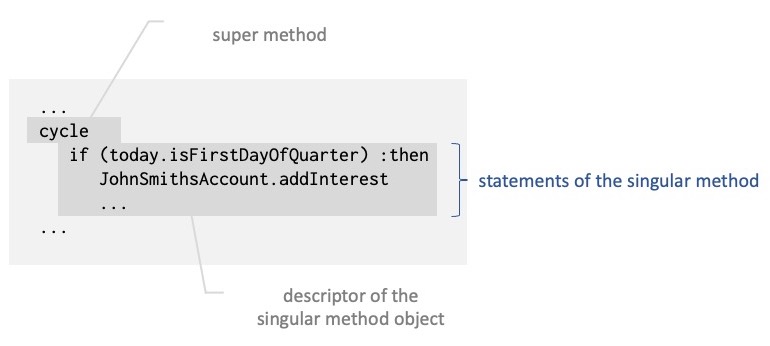The term control structure (+++ perhaps introduced in the section on statements?) is used for statements that control the order of execution of other statements. These include (control) transfer statements, conditional statements, loop statements, and iterators.
Our programming language has some predefined control structures like leave, restart, if:then, if:then:else, for:to:repeat and cycle as used in the previous chapters. Leave and restart are examples of transfer statements; if:then and if:then:else are examples of conditional statements; and cycle and for:to:repeat are examples of loop statements. +++ perhaps the terms used above should be introduced in the section on statements?
The control structures leave, restart, and if:then are primitives (built-in) of qBeta. The other control structures are defined by means of methods. A method defining a control structure is called a control structure method or just control method for short. A control structure method represents an abstraction over all the specific activities like a method and class and is thus also referred to as a control abstraction.
As a first simple example of a control method, we will show how to define the cycle-statement as used in previous sections like in the example below:
cycle
if (today.isFirstDayOfQuarter) :then
JohnSmithsAccount.addInterest
...Here cycle is a method used as a super method of a singular method object – singular method objects are described below.
We define cycle in the following way:
cycle:
inner(cycle)
restart(cycle)Execution of cycle implies that inner(cycle) is executed repeatedly. Execution of inner(cycle) implies that the statements in a possible submethod of cycle are executed.
For the above example this implies that the statement:
if (today.isFirstDayOfQuarter) :then
JohnSmithsAccount.addInterest
...is executed forever unless a leave– or restart is executed within ....
Singular method objects
A statement of the form:
cycle
if (today.isFirstDayOfQuarter) :then
JohnSmithsAccount.addInterest
...is actually an object descriptor derived from cycle, describing an invocation of a singular method object.
We have seen example of singular objects described using obj:
account_1010: obj
owner: val "John Smith"
balance: var floatAs said in section , a singular object is a description of one specific object. It is not an instance of a class.
We may actually declare a similar singular object using cycle as follows
doIt: obj cycle
if (today.isFirstDayOfQuarter) :then
JohnSmithsAccount.addInterest
...However, in most cases we will just use cycle as a statement and the statement:
cycle
if (today.isFirstDayOfQuarter) :then
JohnSmithsAccount.addInterest
...is as mentioned a description of an invocation of a singular method object like doIt declared using obj. The differences are that as a statement the singular method object has no name; the doIt object is generated and executed as part of the enclosing object whereas the singular method object is generated and executed as a statement.

